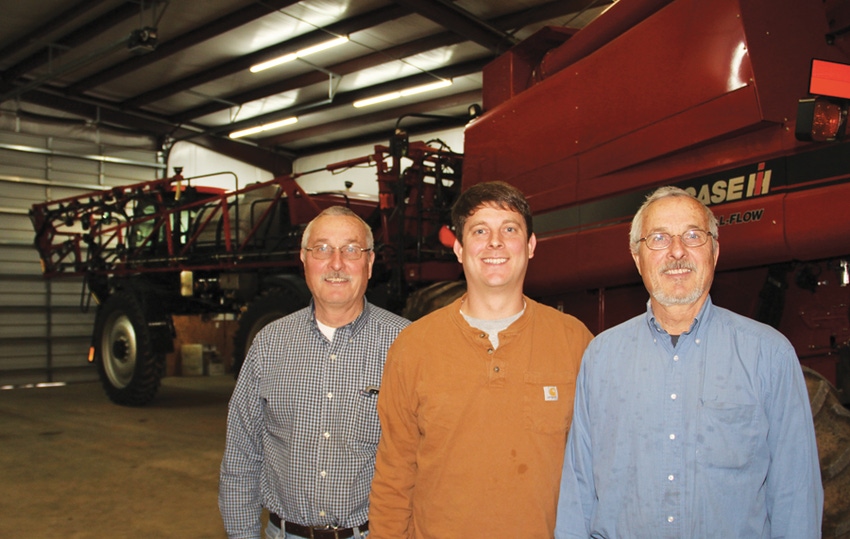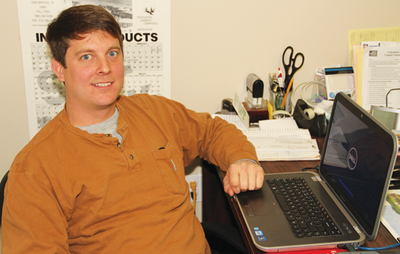
Matt Ormon: He took a chance on a farming career
Matt Ormon readily acknowledges his road from college dropout to established farmer hasn’t been without bumps, but he says, "The opportunity came — suddenly — to do what I knew I wanted to do with my life, and I felt I had to take that chance.”

It was against his parents’ better wishes, says Matt Ormon, that he dropped out of college and gave up his goal of a business degree in order to become a farmer.
“But the opportunity came — suddenly — to do what I knew I wanted to do with my life, and I felt I had to take that chance.”
The farmer for whom he had worked summers and after school while growing up, Mack Thompson, Jr., had died and his land was going to come up for rent.
“He was a good farmer and I had learned a lot from him,” Matt says. “As young as I was, it may have been a little foolish to take on that kind of responsibility, but thankfully, it has worked out well.”
In the years since, he has gradually added acreage and today has a successful corn/soybean operation, new equipment with the latest technology, a spacious metal shop/storage building, a new home nearby, and the added benefit — and pleasure — of working with his father, Mark, and his uncle, Clark, identical twin brothers now retired from their own successful careers.
Mark for 24 years was the elected chancery clerk for Benton County, Miss., and Clark for 33 years was agriculture teacher in area schools. Both had also farmed small acreages on the side, with row crops and cows (which they dropped in 1996), and Matt grew up in a farming environment, liked the independence and the lifestyle.
But, he readily acknowledges, his road from college dropout to established farmer hasn’t been without bumps.
“In 2006, the year my wife, Carol, and I married, our area was in a pocket of severe drought, and while some of our neighbors who got rains were harvesting bumper crops, we ended up cutting 400 acres of soybeans for hay.”
And there was 2009, when it seemed every day brought a gully-washing rain, cutting into yields and hampering harvest.
“If it hadn’t been for crop insurance when those disasters came,” he says wryly, “I probably wouldn’t be farming today.”
Ag news delivered daily to your inbox: Subscribe to Delta Farm Press Daily.
And then there was the surprising year, 2013, which started badly, with a cold, wet spring that dragged on and on. “We made our burndown applications in the mud,” he says.
“Everything was planted late, and we weren’t able to plant as much corn as we’d intended. Then we had a drought in August — less than 1 inch of rain the entire month — and we don’t have irrigation. When we went to the field at harvest time, we thought we were ruined.
“But yields were really good. We averaged 145 bushels on the corn and 42 bushels on the soybeans. The cooler-than-normal temperatures really made a difference. And as it turned out, it was just as well we didn’t get to plant our intended corn acreage, since prices took a drop. We made up for it with the added soybean acreage.”
Benton County, where the Ormons farm, is the seventh smallest county in the state, with a population just over 8,000. A large chunk of the land area, Mark notes, is taken up by the 55,000-acre Holly Springs National Forest. There is also a lot of private timberland, a number of small hobby/weekend farms owned by residents of Memphis, Tenn., and a goodly amount of land that is steep, wooded hills.
Even so, in the northern part of the county, where the terrain is less hilly, there are a number of large farming operations, several with extensive center pivot irrigation systems.
The Ormons farm 1,200 acres and uncles Paul Ormon and Robby Steele, have another 200 acres. “We all work together and use the same equipment,” Matt says. “We do as much of our maintenance as we can. We try not to hire anything out — our only hired labor is our truck driver, Lee Cossitt.
Getting most from acreage
“We’d like to have more land, but there isn’t much potential for expansion. So, our continuing goal is to try and find ways to get as much yield as we can off the acres we have, and to use equipment advances and technology to improve efficiency and hold the line on costs.
“We’ve just bought a bigger planter that we’ll begin using this year — a John Deere 1790. It’s a 12-row 30-inch planter, with splitters for 23 15-inch rows. It’s equipped with GPS, row shut-off, and section control. With our irregular-shaped fields, we feel this precision will allow us realize a savings on the amount of seed used.
“We have a Case IH 3230 sprayer and a Case IH 2577 combine with yield mapping. We just bought a new fertilizer spreader truck and we’ll use the combine yield mapping data for prescription application, which we hope will help to even out yields.
“We have John Deere 3000 receivers and 2600 screens on our tractors, on the combine we have Case IH Pro 600, on the sprayer we have Case IH Pro 700, and on the spreader we have Ag Leader Versa.
“Our two main tractors are John Deere 8220 and 8430. We added auto-steer last year, and we were extremely pleased with the efficiency it adds, the fuel savings, and the reduced fatigue. It also allows us to achieve more precise row alignment, and we were able to pick up a few additional acres over what we’d been able to achieve with eyeballs and row markers.”
And says Matt, his iPhone and iPad are everyday tools. “I have a number of ag-related apps, including one from ADM that will let me see data on a load of corn within minutes after it’s dumped, and another that lets me look at various fertilizer blends, costs, etc. And of course, we all depend on weather radar.”
“Since we’re all dryland, weather and timely rains are important. We’re looking at the potential for irrigation on some of our land, but since most of it is rented, to make that kind of investment would depend on working out agreements with our landlords. One place where we could put a pivot would cross four different landowners. Drilling wells would be prohibitively expensive, so we’d pump out of the Tippah River.
“We rent from 12 different landowners and we farm 56 different fields. All are within a 3-mile to 4-mile radius, so we don’t have to do a lot of equipment moving. Our biggest challenge with these big machines is traveling on narrow, twisty, hilly Hwy. 5. We usually will escort equipment when we’re moving it on the highway.”
Up until a few years ago, Matt says, they no-tilled all their land. “But in 2009, which was extremely rainy, we rutted up fields pretty badly. Also, we’ve had some problems with herbicide-resistant marestail, so we now no-till about 30 percent of our land and on the rest we use a DMI Tigermate II field cultivator and a J&M Crumbler.
“In our herbicide program, we use Sharpen with Roundup for burndown, and last year we added some 2,4-D. Last fall, we sprayed Roundup, 2,4-D, and LeadOff. We hope this will keep the ground clean through spring and help with the marestail.
“Everyone in the area is worried about resistant pigweed. I don’t think we’ve had any — yet. We think it’s better to be proactive with a solid pre-emerge program than to try and fight them after the fact. During the season, Daddy and Uncle Clark will pull out any pigweeds they see.”
Undecided about 2014 crops

TECHNOLOGY, from iPhone to iPad to GPS, is part of Matt Ormon’s strategy for increasing efficiency, boosting yields, and holding the line on costs.
As of early February, Matt says, “We haven’t decided yet about crop acreages for 2014. Corn prices aren’t that promising right now, but we need to rotate some ground each year, and if we can pencil it out and weather cooperates, we’ll probably go back to our usual 300 acres.
“We like to plant corn late March to mid-April, but last year we didn’t get to plant until April 23. We started planting soybeans April 29-30, but then rains kept us out of the fields until May 15.
“We plant mostly Dekalb corn — last year, we planted 6757 — and some Pioneer. Soybeans last year were Asgrow 5532, 5831, 4832, and 4638; Pioneer 94Y61 and 95Y01, and some Dyna-Gro 37RY47 and 31RY45. Most are Group IV and we like to get them in as early as possible. We’ll also plant some indeterminate Group V beans.”
They have four 5,000-bushel storage bins. “Their biggest advantage,” Matt says, “is allowing us to keep the combine moving at harvest, rather than having our truck waiting in an elevator line. Most of our grain is sold off the combine to ADM in Memphis. We normally will forward contract a portion of the crop.
“We have one truck, two hopper bottom trailers, and a dump trailer. We also haul and spread our own lime, based on soil tests. We also do some custom harvesting for other farmers in the area.”
For the last three years, he says, they’ve not had to do any spraying for insects, but made some Quadris fungicide applications for diseases.
The Ormons last grew cotton in the mid-90s. “The boll weevils ate it up and we got out,” says Mark.
“Now that the weevil’s gone, it would be a good rotation crop for us,” says Matt, “but we just can’t justify the cost of equipment to get back into cotton.”
For Mark and Clark, today’s technology-oriented agriculture is a far cry from their earlier-era farming
“Farming is a lot different in terms of equipment, technology, chemicals, and varieties. It’s a whole new game now,” Mark says. “Matt understands computers and the tech stuff, and Clark and I just lend a hand where we can.”
With today’s machinery and technology, says Clark, “We can put in a crop and harvest it so much more quickly. And seeds and varieties are so much better — they’re more costly, of course, but if they have any chance at all, they’re going to yield well.
“We don’t pray for rain any more,” he laughs. “We pray for a good harvest.”
Mark says, “It is a pleasure, working together as a family. Clark and I are from a large family — four boys and four girls. Most of us still live within a few miles of each other, and when we get together on Sunday, there can be as many as 50 people. In an era when families are scattered all over, it’s really great to have to be able to have that kind of togetherness.”
And while Matt says, looking back on it, that forsaking college may have been a giant leap of faith, “I wouldn’t take anything for how things have worked out. Everything has turned out much better than I could have ever dreamed.”
About the Author(s)
You May Also Like



